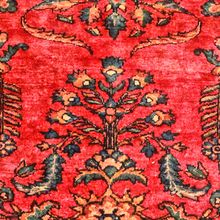Lilihan Rug
| Lilihan Rug | |
|---|---|
 Design of Lilihan Rug (Rugman) | |
| General information | |
| Name | Lilihan Rug |
| Original name | قالی لیلیان |
| Alternative name(s) | Lilihan Carpet |
| Origin | |
| Category | Village |
| Technical information | |
| Common designs | Herati, Afshan, Geometric |
| Common colors | Red, Navy Blue, Beige, Pink, Brown |
| Dyeing method | Natural, Synthetic |
| Pile material | Wool |
| Foundation material | Cotton |
| Knot type | Asymmetrical (Persian) |
Lilihan rugs are produced by Persian Armenian weavers in the Province of Markad in western Iran. Lilihan was formerly the collection point for Armenian single wefted rugs made in the vicinity of Khomeine. Although not too well known in Europe, Lilihan rugs are extremely popular in the United States. These lush, attractive, and extremely durable wool rugs are similar in style, color, and thickness to Sarouks, but are made with a single weft construction and tend to have a longer pile. Lilihan rugs are beautifully woven in the Hamadan weave - single weft is called Hamadan weave or Sennah Baft in which the wefts are rigid and the warps are sinuous. Lilihan rugs are easy to distinguish since there is only one shot of weft between each row of knots.
History
Lilihan village is located in the Arak (Markazi) Province of Iran. Lilihan is populated by Armenians who settled in central Persia during the Safavid period. Rugs and carpets from this village are known in the market from the early twentieth century.
Lilihan rugs have semicurvilinear designs inspired by the weavings of the town of Sarouk. Most designs have an allover style with flowers, branches, Shrub motifs, scrolling leaves, and bouquets facing the center of the rug and decorating the field. The border designs have shrubs and flower heads with leaves and vines.
Early Lilihan rug backgrounds have mostly reds, ranging from tomatored to peach-red, in the field. A small percentage of dark blue and ivory pieces can be found. These three colors were interchangeable in the border and field. In addition to these colors, different shades of red, blue, green, gold, gray, and brown are used for the design elements and outlines. Older Lilihan rugs are shiny and soft to the touch.
The rugs have a cotton foundation and a wool pile, and the Turkish (symmetric) knot is employed. They are generally good to very good in grade quality.
Lilihan rugs are made in formats ranging from mats to small room-sizes, along with runners and gallery sizes. Oversizes up to approximately eighteen feet by twelve feet were woven on rare occasion and can be found in the old rug market. The majority of Lilihan rugs are small, measuring just three feet by two feet to seven feet by five feet. Uncommon narrow width runners ranging from two feet to two feet six inches are made in this village.
By the last quarter of the twentieth century, some Lilihan weavers switched from their previous designs and made rugs similar to neighboring areas in order to satisfy foreign export and domestic demand.[1]
See also
| Search for Lilihan Rug on Wikipedia. |
References
- ↑ Moheban, 2015, 350
Bibliography
- Abraham Levi Moheban. 2015. The Encyclopedia of Antique Carpets: Twenty-Five Centuries of Weaving. NewYork: Princeton Architectural Press.